Search results for: 'Stone to'
-
 Campanian red figure Hydria with thermoluminescence analysis
Campanian red figure Hydria with thermoluminescence analysisFrom the workshop of the Branicki painter, 330 - 320 BC, Cumae. Impressive large vase in very nice condition.
Price: on request Paleolithic hand axe of Homo Erectus
Paleolithic hand axe of Homo ErectusBig hand axe from Niger. Made during the Old Stone Age, around 200,000 years ago. The universal stone age tool could be use as a borer or cutting tool.
Price: on request Stylized Bes mask
Stylized Bes maskHighly stylized miniature mask of the god Bes from ancient Egypt. Stone with nice texturing.
€250 Neolithic sickle from Denmark
Neolithic sickle from DenmarkCrescent-shaped blade made of beautiful brown flint. This tool represents an intermediate state within the radical transition from Neolithic to Bronze Age.
€700 Neolithic flint sickle from Denmark
Neolithic flint sickle from DenmarkCrescent-shaped blade made of beautiful brown flintstone. This tool represents an intermediate state within the radical transition from Neolithic to Bronze Age.
€530 Neolithic flint sickle from Denmark
Neolithic flint sickle from DenmarkCrescent-shaped blade made of beautiful reddish-brown flintstone. This tool represents an intermediate state within the radical transition from Neolithic to Bronze Age.
€520 Egyptian heart scarab
Egyptian heart scarabBig beetle stone from the Late Period of Ancient Egypt. Scarabs of this kind have been placed next to the heart on mummies. Nice mint green fayence.
Price: on request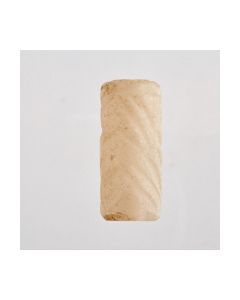 Mesopotamian cylinder seal with abstract scene
Mesopotamian cylinder seal with abstract sceneThe milky white stone is engraved with a scene that stands out by its high degree of abstraction. Late Uruk to Djemdet Nasr period, around 3000 BC.
Price: on request Large paleolithic hand axe
Large paleolithic hand axePrehistoric stone tool made of wonderfully banded stone. It was the universal tool of the older Stone age and could be used as a borer or a cutter. From a Swiss museum collection. Found in Morocco, North Africa.
Price: on request Neolithic axe head
Neolithic axe headFinely crafted tool from the New Stone Age of Europe. A specimen of the thin butted type.
Price: on request Powerful and heavy work axe
Powerful and heavy work axeRare and impressively large and heavy tool from the New Stone Age. The axe type comes from Jutland, Denmark.
Price: on request Large Paleolithic hand axe
Large Paleolithic hand axePrehistoric stone tool. It was the universal tool of the older Stone age and could be used as a borer or a cutter. From a Swiss museum collection. Found in Foggaret Ezzaouia, Algeria, North Africa.
Price: on request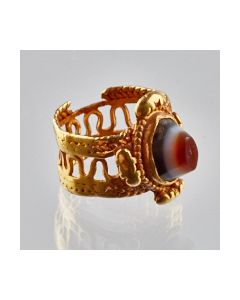 Skillful golden ring with insert agate
Skillful golden ring with insert agateThe fingerring dates to Late Roman times. It recalls the glory of the rich families of Rome. The elaborately ornamented ring holds an agate stone with beautiful coloured layers.
Price: on request Polychromic Roman mosaic showing a fish
Polychromic Roman mosaic showing a fishMuseal erhaltenes Paneau, sehr intensive, leuchtende Farben. Herausragendes, ungewöhnlich gearbeitetes Stück.
Price: on request Three neolithic arrowheads from Egypt
Three neolithic arrowheads from EgyptThe Stone Age points are finely crafted and well preserved. From a 100 year old museum collection.
Price: on request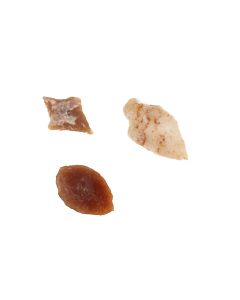 Three neolithic arrowheads from Egypt
Three neolithic arrowheads from EgyptThe Stone Age points are finely crafted and in a good state of preservation. From a 100 year old museum collection.
€120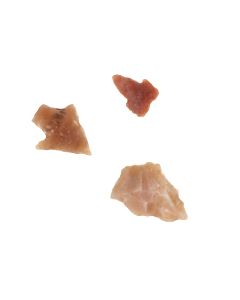 Three neolithic arrowheads from Egypt
Three neolithic arrowheads from EgyptThe Stone Age points are finely crafted. From a 100 year old museum collection.
Price: on request Three neolithic arrowheads from Egypt
Three neolithic arrowheads from EgyptThe Stone Age points are finely crafted. From a 100 year old museum collection.
€120 Large neolithic axe head
Large neolithic axe headA tool from the Early Neolithic of Europe. Nicely polished and impressive by its size and weight.
Price: on request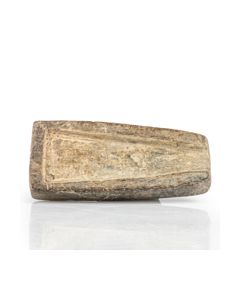 Bronze Age casting mould for a flat axe
Bronze Age casting mould for a flat axeOne half of a stone mould for bronze casting an axe head. The equipment is from a workshop of the 2nd Millennium BC, probably from the Carpathian Basin. From the famous Guttmann Collection. This mould was published in a work by Born and Hansen.
Price: on request Neolithic axe head with through hole
Neolithic axe head with through holeFinely crafted tool from the New Stone Age of Europe. Made from greenish grey rock. With a through hole at the neck as a remarkable feature.
Price: on request Conoid stamp seal with spade of Marduk
Conoid stamp seal with spade of MardukThe stamp shows the spade of Marduk, patron deity of the city of Babylon. Above a crescent, symbolizing the moon god Sin. 7th to 6th century BC.
Price: on request Old Babylonian cylinder seal
Old Babylonian cylinder sealThis Old Babylonian seal with a worship scene is made from lapis lazuli, a very rare choice for this period.
Price: on request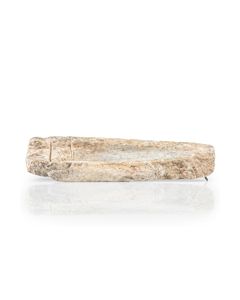 Bronze Age casting mould for a chisel
Bronze Age casting mould for a chiselOne half of a stone mould for bronze casting. The equipment is from a workshop of the 2nd Millennium BC, probably from the Carpathian Basin. From the famous Guttmann Collection. This mould was published in a work by Born and Hansen.
Price: on request Three neolithic arrowheads from Egypt
Three neolithic arrowheads from EgyptThe Stone Age points are beautifully crafted. From a 100 year old museum collection.
Price: on request Early flat axe from Judea
Early flat axe from JudeaInteresting bronze axe head from Early Bronze Age. The piece was found in Judea.
Price: on request Early flat axe from Judea
Early flat axe from JudeaCompact bronze axe head from Early Bronze Age. The piece was found in Judea.
Price: on request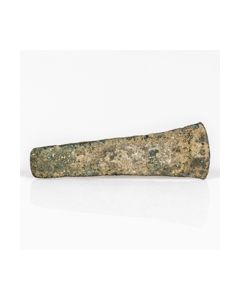 Early flat axe from Judea
Early flat axe from JudeaTrapezoidal axe head from Early Bronze Age. The piece was found in Judea.
Price: on request Three neolithic arrowheads from Egypt
Three neolithic arrowheads from EgyptThe Stone Age points are finely crafted. From a 100 year old museum collection.
Price: on request Three neolithic arrowheads from Egypt
Three neolithic arrowheads from EgyptThe Stone Age points are finely crafted. From a 100 year old museum collection.
Price: on request Three neolithic arrowheads from Egypt
Three neolithic arrowheads from EgyptThe Stone Age points are finely crafted. From a 100 year old museum collection.
Price: on request Three neolithic arrowheads from Egypt
Three neolithic arrowheads from EgyptThe Stone Age points are finely crafted. From a 100 year old museum collection.
€120 Three neolithic arrowheads from Egypt
Three neolithic arrowheads from EgyptThe Stone Age points are finely crafted. From a 100 year old museum collection.
Price: on request Three neolithic arrowheads from Egypt
Three neolithic arrowheads from EgyptThe Stone Age points are finely crafted. From a 100 year old museum collection.
Price: on request Roman facade decoration shaped as theatre mask
Roman facade decoration shaped as theatre maskImpressive and striking marble mask. It once adorned the upper facade of a villa or a public building during Roman Imperial times.
Price: on request Bronze Age casting mould for a chisel
Bronze Age casting mould for a chiselOne half of a stone mould for bronze casting. The equipment is from a workshop of the 2nd Millennium BC, probably from the Carpathian Basin. From the famous Guttmann Collection. This mould was published in a work by Born and Hansen.
€1,400

